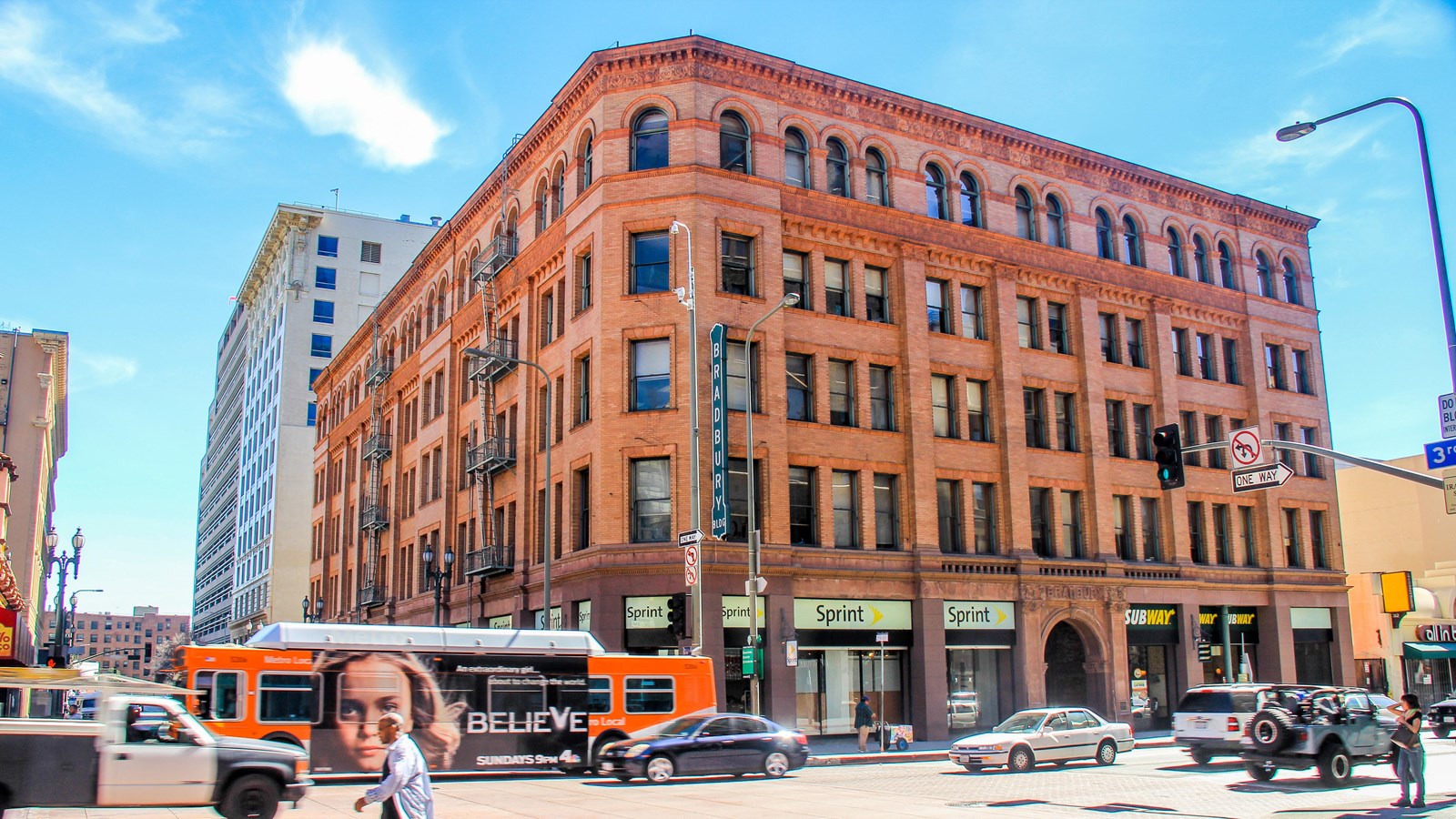Last updated: June 6, 2022
Place
California: Broadway Theater and Commercial District

Photo by MikeJiroch, CC BY-SA 3.0, https://creativecommons.org/licenses/by-sa/3.0, no changes
The many buildings and myriad of architectural styles in the Broadway Theater and Commercial District reveal the exuberance of the early entertainment industry in Southern California. When commercial activity in Los Angeles turned south down Broadway early in the 20th century, it created a thoroughly modern environment for extravagant shopping and flamboyant theaters. As the western terminus of Route 66 between 1926 and 1936, the district was a portal to coastal California for a national audience ranging from Dust Bowl refugees to pleasure-seeking tourists.
Broadway is the ultimate example of the explosive growth of Los Angeles and Southern California between 1900 and 1910. Prior to the turn of the century, Los Angeles’ commercial center was the intersection of Spring and First Streets, and Broadway below Third Street was primarily residential. The construction of a new city hall between Second and Third Streets in the late 1800s was a catalyst in reorienting the commercial district south, along Broadway. The street’s most dramatic turning point, however, was the 1905 announcement that Hamburger’s would build a large department store at Broadway and Eighth Street. Despite concerns that its Eighth Street location was too far south, investors followed Hamburger's to the area.
Perhaps the concerns of skeptics were allayed when Hamburger’s new store opened with its dramatic Beaux Arts exterior and deeply recessed, arched entryway surrounded by an upper frieze and flanking Doric pilasters. The five-story building boasted largest store aisle in the United States, and the Los Angeles Herald asserted that on the first day of business, 35,000 people came to ride the building’s escalator, the only one west of St. Louis. By the time Hamburger’s was complete, multiple-story retail and office buildings surrounded it, and Broadway was the commercial thoroughfare of the city. Nearly two dozen major department and clothing stores and manifold smaller venders operate in the Hamburger’s building and other historic retail buildings today, and the district continues to bustle with buyers and sellers.
The development of Broadway as a commercial district coincided with its emergence as a theatrical center. At the turn of the century, the major theaters of Los Angeles were along Main Street, which parallels Broadway two blocks to the southeast. In 1903, however, the Mason Opera House opened on Broadway. As various theater owners vied for the title of city impresario, theaters along Broadway became larger and more numerous. The Orpheum, now the Palace, was one of the first theaters to locate within the present district. The Palace Theatre’s French Renaissance appearance established the early preference for that style, and its terra cotta facade included eye-catching carved figures. Theater architecture became increasingly flamboyant, creating a diverse and colorful streetscape. The Globe Theatre’s gargoyles, the corner clock tower on the Tower Theatre, and the Los Angeles Theatre’s eagles all reflected the ebullient mood of the district. The Roxie Theatre, constructed in 1931 and a relative latecomer, employed the popular Art Deco style for its flowery patterns and grillwork. Twelve of these 1910 to 1931 movie palaces remain, many now used as special-event venues, filming locations, and retail operations, and their fanciful exteriors lend elegance to the district.
For decades, Broadway provided a major source of revenue, a location for premieres, and copy for the gossip columns of Southern California, before transitioning into a vibrant Latino shopping district. In large part, the stores and theaters built on Broadway nearly a century ago survive, but until a decade ago, the upper stories stood vacant. Since then, the district has become a laboratory for adaptive reuse, as loft-style apartments and condominiums lend new life to former office and retail space. The National Park Service listed the district in the National Register of Historic Places in 1979, and expanded the listed district’s size in 2002. In 1999, the Los Angeles Conservancy, active on Broadway for 20 years, joined members of the city council, the mayor’s office, property owners, and other stakeholders to launch Bringing Back Broadway, an ongoing effort that focuses attention on and investment in the district’s rich architecture and cultural potential.
The Broadway Theater and Commercial District includes approximately seven blocks along South Broadway in Los Angeles, CA; its northern boundary is midway between West Second St. and West Third St. and the southern boundary is between West Ninth St. and West Olympic St.
The Los Angeles Conservancy offers tours of the district. For more information, call 213-430-4209 or visit the Los Angeles Conservancy website.
The Bradbury Building is located at 304 South Broadway. For more information, call 213-626-1893.
The Los Angeles Theatre is located at 615 South Broadway and is used for screenings and other special events. For more information, call 213-629-2939 or visit the Broadway Theatre Group website.
The Million Dollar Theater is located at 307 South Broadway and hosts special events and location filming. For more information, call 213-617-3600.
The Orpheum Theatre is located at 842 South Broadway and still hosts live performances, special screenings, and other events, and is available for location filming. Call 877-677-4386 or visit the Orpheum Theatre website.
See the Broadway Theatre and Commercial District National Register nomination form.
